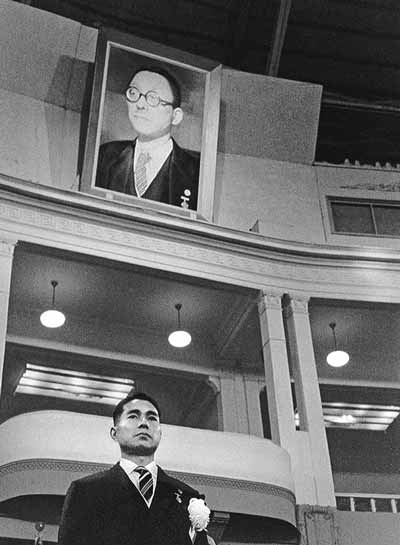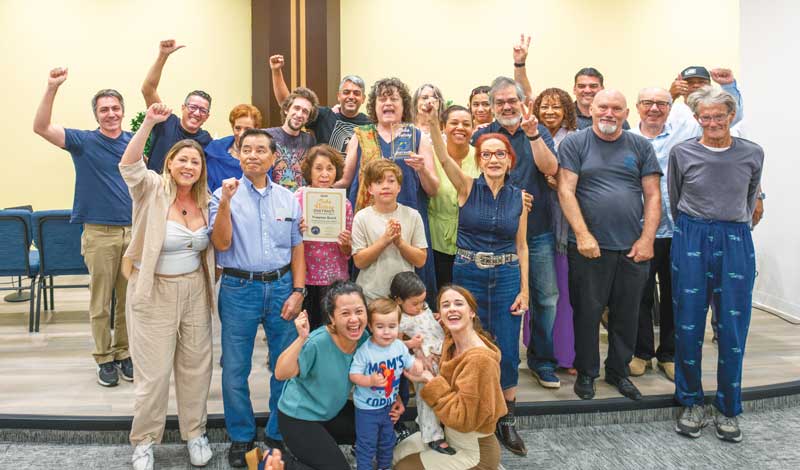The following essay appears in The Wisdom for Creating Happiness and Peace, part 3, revised edition, pp. 315–19. It was translated from the May 2, 2004, issue of the Soka Gakkai’s daily newspaper, Seikyo Shimbun.
On May 3, 1960, two years after second Soka Gakkai President Josei Toda’s death, Daisaku Ikeda became the third Soka Gakkai president. Five months later, on Oct. 2, he embarked on the first of his overseas travels for worldwide kosen-rufu. In this selection, he recounts how, at each 10-year milestone of his presidency, he overcame a great obstacle and opened the way to the Soka Gakkai’s development as a global Buddhist movement.
I was inaugurated as the third president of the Soka Gakkai at the age of 32, on May 3, 1960.
On that clear day, I stood on the stage of the Nihon University Auditorium and declared with youthful vigor to the 20,000 members there: “Though I am young, from this day I will take leadership as a representative of second Soka Gakkai President Josei Toda’s disciples and advance with you another step toward the substantive realization of kosen-rufu.”[1]
I was enveloped in thunderous, enthusiastic applause.
As a disciple of Josei Toda, the great leader of propagation, I vowed to realize the membership goal of 3 million households that he had entrusted to me.
Before his death, Mr. Toda had said to me: “What a magnificent age it will be when there are 10 million people practicing Nichiren Buddhism! I can’t wait!”
I made it my lifetime vow to build here in Japan a solid grassroots network, 10 million strong, dedicated to peace and humanity.
Nichiren Daishonin states, “The ‘great vow’ refers to the propagation of the Lotus Sutra [Nam-myoho-renge-kyo]” (The Record of the Orally Transmitted Teachings, p. 82).
May 3 has become the day of reaffirming our vow for kosen-rufu. On this day each year, we of the Soka Gakkai, united by the bonds of mentor and disciple, pledge afresh to spread the Mystic Law and make renewed efforts to realize our noble cause. And so it will be forever.

There is a passage from “The Opening of the Eyes” that I took as my own determination upon becoming Soka Gakkai president and that has remained firmly in my heart ever since: “Let the gods forsake me. Let all persecutions assail me. Still I will give my life for the sake of the Law” (“The Opening of the Eyes,” The Writings of Nichiren Daishonin, vol. 1, p. 280).
I prided myself on having been trained by my mentor to have an invincible spirit that could withstand every possible form of adversity.
The path to achieving great things is never smooth or easy.
Giving up is a source of despair and defeat, but persevering is a source of hope and victory.
It has been my destiny since becoming Soka Gakkai president to have to surmount an unending series of towering, perilous peaks stretching as far as the eye can see.
I encountered the first in 1970. May 3 of that year, marking the 10th anniversary of my presidency, saw the Soka Gakkai under intense attack in the so-called Freedom of Speech Incident.[2]
The next decade also brought a series of trials and tribulations, like mountains piling on mountains. I stepped down as Soka Gakkai president just before May 3, 1979, amid the raging storm of the first priesthood issue.[3]
The following year, 1980, also saw a volley of attacks launched at me and the Soka Gakkai. Treacherous former members, lacking any sense of gratitude, had colluded with corrupt, scheming priests and thereby revealed themselves to be just like Devadatta, the renegade disciple who attacked and tried to kill Shakyamuni Buddha.
Amid that fierce battle, I went to Kansai, our ever-victorious bastion. And on May 3, 1980, with Kansai as my base of operations, I made a powerful determination to vanquish the intrigues of these unscrupulous, self-serving individuals and launched a struggle for ultimate victory.
It is precisely because the Soka Gakkai has experienced and overcome such terrible attacks that it has been able to create the strongest foundation in all Japan as an organization of integrity and solidarity dedicated to the highest ideals.
It was at the start of the next decade, 1990, the year marking the 30th anniversary of my becoming president, that the second priesthood issue took place.[4] This revealed the devilish nature of Nichiren Shoshu’s high priest Nikken Abe and his supporters in the priesthood as the destroyers of kosen-rufu.
While these corrupt priests secretly plotted in dark backrooms to undermine the Soka Gakkai, our organization was opening its doors wide to the world and forging ahead in harmonious unity to expand our great peace movement for the happiness of all humanity.
The frequency of my dialogues with world leaders and thinkers also increased rapidly from around this time. It was in 1990 that I first met President Mikhail Gorbachev of the Soviet Union and President Nelson Mandela of South Africa.
As I have just described, major challenges have occurred roughly every 10 years since I became Soka Gakkai president.
But each time, the Soka Gakkai continued growing— becoming an unsurpassed organization of culture, a peerless community of believers genuinely practicing the Daishonin’s teachings and a global Buddhist movement. In conquering each daunting mountain peak in its path and winning victory after victory, the Soka Gakkai has become an unrivaled champion.
On May 3, 1960, as I was about to leave the Nihon University Auditorium after the reception following my inauguration, someone shouted, “Time for a victory toss!” That instant, the youth let out a jubilant roar and rushed toward me. Before I knew what was happening, they had picked me up and were tossing me in the air with cheers of celebration. I will never forget that surging whirlpool of joy, its powerful force, its dynamic energy, as long as I live.
It is impossible for me to advance kosen-rufu without fellow members who struggle alongside me. It is not me who is important but the members.
Time and time again, Mr. Toda told us, “If the members all support the third president, kosen-rufu will surely be achieved.” And it has turned out just as he said.
True to my mentor’s assertion, the Soka Gakkai has succeeded in spreading our movement for kosen-rufu around the globe, precisely because our dedicated members and I, the third president, have struggled together in the spirit of “many in body, one in mind.”

‘Let Us Encourage Each Other and Advance Together’
Ikeda Sensei once defined encouragement in the realm of Soka as “shining the light of the Mystic Law on all people, awakening their inherent Buddhahood and revitalizing their lives at the most fundamental level” (The Wisdom for Creating Happiness and Peace, part 1, revised edition, p. xiv).
His writings, speeches, lectures, dialogues and poetry, from a lifelong struggle of words, at one in heart with his mentor, Josei Toda, is a crystallization of that spirit.
These works have been compiled in Japanese into 150 volumes of collected works. But as that process neared completion, the idea was proposed to compile a selection of excerpts from those volumes for the new era of worldwide kosen-rufu. Thus, The Wisdom for Creating Happiness and Peace was serialized in English in Living Buddhism and later compiled into book form as a three-part series.
With the wish to both return to and expose future generations to Sensei’s foundational works, the World Tribune will begin printing the essays from his series in each issue, starting here, on May 3, Soka Gakkai Day.
In the preface to the first book, dated Aug. 14, 2020, the 73rd anniversary of his first Soka Gakkai meeting, Sensei recalled this poem from his mentor, President Toda:
The journey to propagate
the Mystic Law
is long;
let us encourage each other
and advance together.
Sensei continued: “Let us, therefore, ‘encourage each other and advance together’ as we continue on our journey to propagate the Mystic Law into the eternal future of the Latter Day of the Law!
Nothing would give me greater pleasure than if this book provides encouragement and sustenance to Soka Gakkai members everywhere as they proceed along that path” (WCHP, part 1, revised edition, p. xix).
May 3, 2025 World Tribune, pp. 2–3
References
- The substantive realization of kosen-rufu: This refers to propagating Nichiren Daishonin’s teaching of Nam-myoho-renge-kyo in society. In other words, it is establishing happiness, peace and security in the real world based on the Mystic Law, through each individual carrying out their personal mission as a Bodhisattva of the Earth. ↩︎
- Freedom of Speech Incident: The name given to a controversy that arose in 1970 when the Soka Gakkai tried to defend itself from libel. For further details, see the “Fierce Winds” chapter of The New Human Revolution, vol. 14. ↩︎
- First priesthood issue: On April 24, 1979, Daisaku Ikeda stepped down as third Soka Gakkai president to shield the members from the perverse machinations of the Nichiren Shoshu priesthood, which had colluded with corrupt former Soka Gakkai members to wrest control of the lay organization. While Ikeda Sensei’s activities in Japan continued to be curtailed by the priesthood, he turned his focus to opening the path of worldwide kosen-rufu as the president of the SGI. ↩︎
- Second priesthood issue: On Nov. 28, 1991, the Nichiren Shoshu priesthood excommunicated more than 12 million SGI members in a desperate attempt to wrest control of the lay organization and its resources. The priesthood had strongly advocated a doctrine of absolute superiority and authority of priests over laity—one that contradicts the spirit of equality that pervades Nichiren Daishonin’s teachings. The vast majority of members throughout the world recognized the corruption, inhumanity and distortion behind the priesthood’s actions and chose to continue practicing within the SGI under the leadership of Ikeda Sensei. SGI members today celebrate Nov. 28 as our “Day of Spiritual Independence.” ↩︎
You are reading {{ meterCount }} of {{ meterMax }} free premium articles

